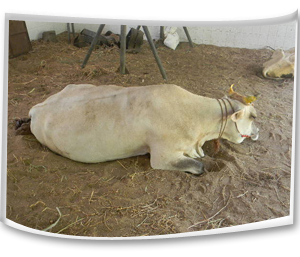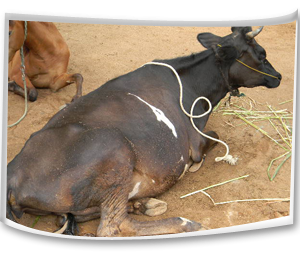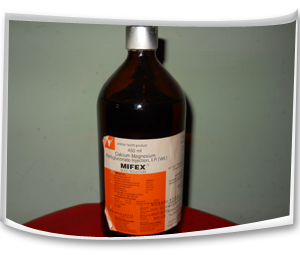|
Metabolic diseases of Cattle and Buffalo
Parturient paresis (Milk fever)
| Nature of disease |
|
- Parturient paresis is a metabolic disease occurring most commonly within 72 hours of parturition in adult females.
- It is frequently found in high yielding Jersey cows.
- Amongst cattle, mature and old cows are most commonly affected usually in the 5-10 year age group.
- High yielding dairy cows are mainly susceptible to the disease especially during their 3rd, 4th or 5th pregnancy or parturition.
- This is characterized by recumbency, muscle tremors and becomes normal after calcium borogluconate ingestion.
|
| |
Causes |
- A depression of the level of ionized calcium in tissue fluids.
- Excessive drainage of calcium in the milk just after parturition.
- Excessive loss of calcium in the colostrum beyond the capacity of absorption from the intestine and mobilization from the bones to replace.
- An impairment of absorption of calcium from the intestine at parturition.
- Deficiency of Vit. D and less acidic pH in gut.
- The mobilization of calcium from storage in the skeleton may not be sufficiently rapid to maintain normal serum level.
- Sometimes milk fever is associated with hypocalcaemia, hypophosphataemia and hypomagnesaemia.
- There is a special susceptibility if the animal is subjected to any stress. Forced exercise, long distance transport, sudden deprivation of food and grazing on oxalate containing plants or green cereal crops may precipitate the condition.
- Non –parturient Milk Fever occurs in any situation which may impose severe stress or starvation of feed deprivation may be the factors which may ultimately produce a sudden shift in calcium balance leading to hypocalcaemia.
|
|
 |
| |
Clinical symptoms |

Animal unable to stand after parturition |
- There is muscle weakness and flaccidity of muscles.
- Tremor is found in the eye and muzzle.
- Animal may rest on sternum.
- There is diminished consciousness and the animal may show drowsy condition.
- There is lateral kink in the neck or head may rest on the flank (‘S’ shaped posture).
- The skin and the extremities remain cold. Temperature is generally subnormal.
- Muzzle becomes dry.
- Mucous membrane of the eye also turns dry with dilated pupil.
- Eyes are unable to blink.
- There is relaxation of anus.
- Venous pressure is low as such it may difficult to raise the jugular vein.
- There is atony of the rumen leading to constipation.
- The animal may be in lateral placement.
- There is complete flaccidity for which animal cannot sit up.
- Due to recumbency bloat is evident.
- There may be Anuria and oliguria due to paresis of muscles
|

Animal unable to stand after parturition |
| |
|
 |
| Suggested first aid |
|
- Treat the animals as early as possible before the cow become recumbent.
- Bring the animal to sternal recumbency until treatment is available.
- Bring the recumbent cows from slippery floors to non-slippery areas.
- If the animals are lying in the open ground, erect a temporary shelter to protect from sun light.
- Immediately after evidence of milk fever signs and recumbency, consult with qualified veterinarian for calcium administration.
|
| |
Prevention Method |

Oral Calcium Drench |
- A diet containing less than 20 gm of calcium per day should be fed during the last two weeks prior to calving to prevent milk fever.
- Avoid excess calcium intake during the dry period. Diet containing less than 80 to 100gm/ day of calcium throughout the dry period may be fed to prevent milk fever.
- Phosphorus intake of less than 35 gm/ day may be the standard level for the prevention of milk fever.
- High phosphorus and low calcium level during the last month of pregnancy may be maintained to prevent milk fever (Ca: P= 1:3.3).
- Diets containing higher level of chloride and sulphur - anions relative to sodium and potassium cations may prevent occurrence of the diseases. Excess anions help in the absorption of calcium.
- Administration of ammonium chloride 3 weeks before parturition may be a useful method of prevention.
- Use of Vitamin D3 and its metabolites has been an effective approach to prevent milk fever. A single intramuscular injection @ 10 million unit 3-8 days prior to parturition may be made. A dose of 1 million units for every 45 kg body weight would be a rational preventive approach.
- Oral calcium gel dosing (50% calcium chloride) has been suggested at prior to calving, at calving, 12 hours post calving and 24 hours of post calving to prevent milk fever.
- Addition of lime stone water in the drinking water prior to parturition will prevent this condition.
- Avoid over fattening in the pre-partum period.
- Avoid stresses at the time of parturition.
- Provide a clean, well- bedded box stall for calving.
- Make frequent observation of cows prone to milk fever from 48 hours after parturition for signs of milk fever and treat them promptly if any signs are exhibited.
|

Oral Calcium Gel |
| Control Method |
|
- Calcium borogluconate-25% 500 ml slow Intravenous injection 10-20 drops/ minute.
- Compounds containing cal-Mg-Boro-gluconate-200 to 350ml I/v followed by S/c for rest of dose.
|

Calcium Injection |
|
 |
|